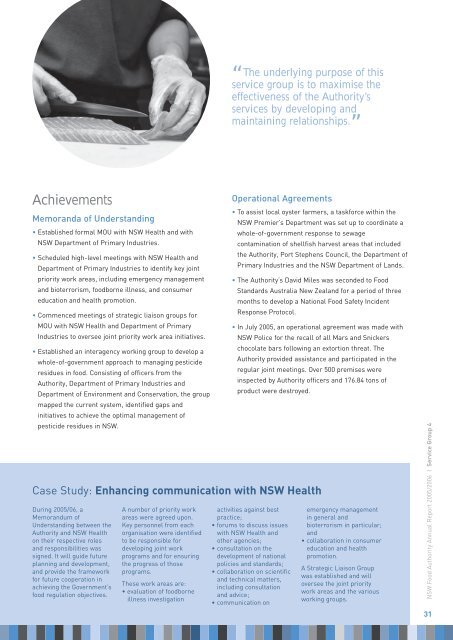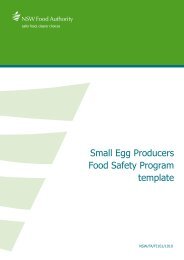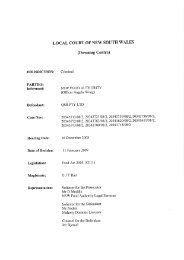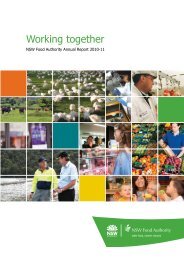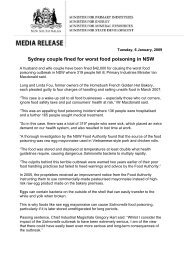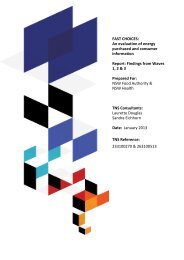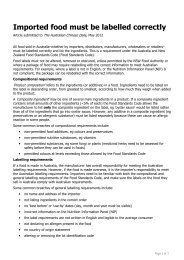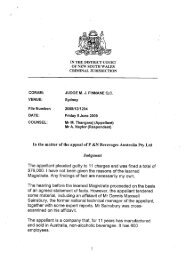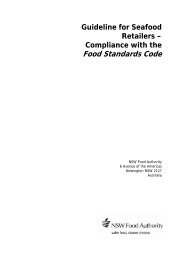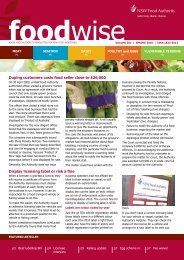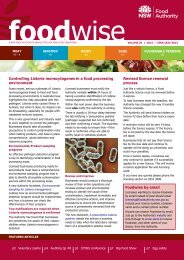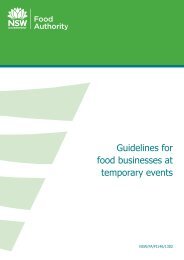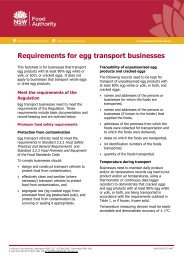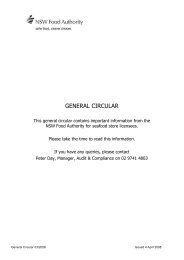Annual Report 2005-06 - NSW Food Authority - NSW Government
Annual Report 2005-06 - NSW Food Authority - NSW Government
Annual Report 2005-06 - NSW Food Authority - NSW Government
Create successful ePaper yourself
Turn your PDF publications into a flip-book with our unique Google optimized e-Paper software.
“The underlying purpose of thisservice group is to maximise theeffectiveness of the <strong>Authority</strong>’sservices by developing andmaintaining relationships. ”AchievementsMemoranda of Understanding• Established formal MOU with <strong>NSW</strong> Health and with<strong>NSW</strong> Department of Primary Industries.• Scheduled high-level meetings with <strong>NSW</strong> Health andDepartment of Primary Industries to identify key jointpriority work areas, including emergency managementand bioterrorism, foodborne illness, and consumereducation and health promotion.• Commenced meetings of strategic liaison groups forMOU with <strong>NSW</strong> Health and Department of PrimaryIndustries to oversee joint priority work area initiatives.• Established an interagency working group to develop awhole-of-government approach to managing pesticideresidues in food. Consisting of officers from the<strong>Authority</strong>, Department of Primary Industries andDepartment of Environment and Conservation, the groupmapped the current system, identified gaps andinitiatives to achieve the optimal management ofpesticide residues in <strong>NSW</strong>.During <strong>2005</strong>/<strong>06</strong>, aMemorandum ofUnderstanding between the<strong>Authority</strong> and <strong>NSW</strong> Healthon their respective rolesand responsibilities wassigned. It will guide futureplanning and development,and provide the frameworkfor future cooperation inachieving the <strong>Government</strong>’sfood regulation objectives.A number of priority workareas were agreed upon.Key personnel from eachorganisation were identifiedto be responsible fordeveloping joint workprograms and for ensuringthe progress of thoseprograms.These work areas are:• evaluation of foodborneillness investigationOperational Agreements• To assist local oyster farmers, a taskforce within the<strong>NSW</strong> Premier’s Department was set up to coordinate awhole-of-government response to sewagecontamination of shellfish harvest areas that includedthe <strong>Authority</strong>, Port Stephens Council, the Department ofPrimary Industries and the <strong>NSW</strong> Department of Lands.• The <strong>Authority</strong>’s David Miles was seconded to <strong>Food</strong>Standards Australia New Zealand for a period of threemonths to develop a National <strong>Food</strong> Safety IncidentResponse Protocol.• In July <strong>2005</strong>, an operational agreement was made with<strong>NSW</strong> Police for the recall of all Mars and Snickerschocolate bars following an extortion threat. The<strong>Authority</strong> provided assistance and participated in theregular joint meetings. Over 500 premises wereinspected by <strong>Authority</strong> officers and 176.84 tons ofproduct were destroyed.Case Study: Enhancing communication with <strong>NSW</strong> Healthactivities against bestpractice;• forums to discuss issueswith <strong>NSW</strong> Health andother agencies;• consultation on thedevelopment of nationalpolicies and standards;• collaboration on scientificand technical matters,including consultationand advice;• communication onemergency managementin general andbioterrorism in particular;and• collaboration in consumereducation and healthpromotion.A Strategic Liaison Groupwas established and willoversee the joint prioritywork areas and the variousworking groups.<strong>NSW</strong> <strong>Food</strong> <strong>Authority</strong> <strong>Annual</strong> <strong>Report</strong> <strong>2005</strong>/20<strong>06</strong> I Service Group 431


